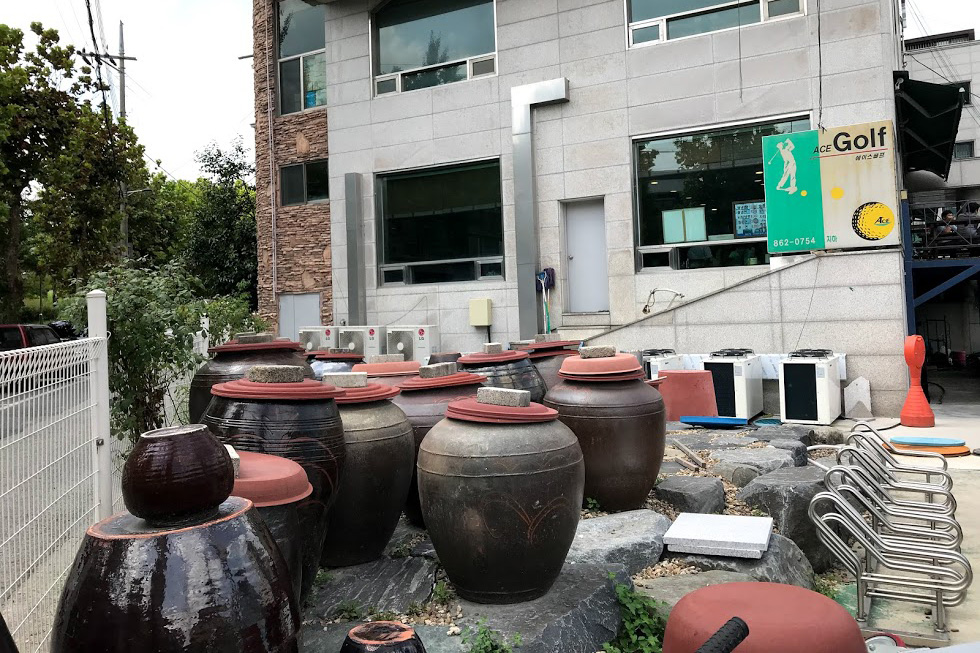Sometimes you don’t appreciate what is right in front of you. Sometimes you might not even notice something until someone else, a stranger perhaps, points it out to you.
For me, as a Korean, onggi—earthenware jars used to store fermented foods and condiments—is a good example of this. Onggi evokes an image of traditional lifestyle for many Koreans, but it is also an item that is so humble that few recognize it as something important. It is something we know but don’t really think about. So it was surprising for me to come to Washington, D.C., and find a number of onggi on prominent display in the office of the Smithsonian Center for Folklife and Cultural Heritage.

Before the apartment building boom of the 1980s and 1990s, every Korean household had a dedicated outdoor area called the jangdokdae, which was used to hold food storage jars—the onggi. As a child, I was in charge of going out to the jangdokdae to take out salted seafood or pickled vegetables and other seasonings such as soy sauce (gan-jang), soybean paste (doen-jang), and chili pepper paste (gochujang) when my mom needed these for cooking. Later, when I got married, my mother-in-law gave me an onggi pot of rice as one of my first housewarming presents.
Until fairly recently, Koreans did not really recognize the value of onggi. It was utilitarian, used in everyday life, and affordable compared to classic Korean ceramics such as Goryeo celadons or the white porcelains of Joseon. While these porcelains have been praised and appreciated for their artistic value and traded at high prices as antiques, onggi, the humble container, was not an object of value or interest even for scholars.
It was in 1971, just as Korea’s rapid industrialization was beginning and plastic housewares were starting to replace traditional utensils—including onggi—that Smithsonian Folklife Festival director Ralph Rinzler made his first visit to South Korea. He was there with his wife to work with a school for orphan girls.
The sight of a few dark earthenware jars at the side of a village yard made a strong impression, inspiring Rinzler to do some fieldwork at nearby onggi kilns. He saw certain parallels to the utilitarian pottery traditions he was familiar with in the American South. In 1972, he returned to Korea to investigate further.


Rinzler returned a decade later with anthropologist Robert Sayers to continue the work and invite a group of Korean artists and performers to participate in the 1982 Smithsonian Folklife Festival as part of the Korea-U.S. Centennial program. This research became the main content of the book The Korean Onggi Potter, which they published in 1987. In addition to reviewing the history of onggi pottery, the book provides a glimpse into the relatively marginalized lives of the potters, who mostly lived in company housing and had to move frequently as production demands shifted.
One of the potters they interviewed in 1981 was Shim Sang-un, who attended the 1982 Festival and made one of the onggi jars on display in the Festival’s office.

As Rinzler and Sayers correctly assumed, onggi gradually lost its prominence in daily Korean life as refrigerators and plastic containers were introduced to every household. As a consequence, the onggi industry has shrunk—but not disappeared.
Since the 2000s, a “well-being” boom has inspired public interest in natural foods and traditional dietary practices. People are interested in the idea of producing and storing food in a traditional way that could benefit the human body. Food engineering scientists have analyzed the materials of onggi, noting the special qualities the porosity of the pots provides, which has earned them the nickname “the Breathing Bowl.”
In spite of the publicity, the use of onggi today differs from the past. In the home, people keep only a few small jars, often commercially made, for chili paste and pickled vegetables. But in the food industry, traditional onggi is used widely. Small- and mid-sized brands purchase large quantities of the huge pots and use them for visually promoting their products as environmental friendly and traditionally made to appeal to health-conscious consumers. Ironically, consumers buy these products in plastic containers, which they then store in their refrigerators.
As Rinzler had come to realize during his first visit to South Korea, onggi was an important example of Korea’s traditional culture but was facing a shortage of apprentices to carry on the tradition. In 1990, the Korean government designated onggi pottery making as an example of National Intangible Cultural Heritage, and it has honored some distinguished onggi potters as “Living Human Treasures.” Through the government’s support of apprenticeships, the art of onggi making is now actively transmitted to a younger generation of artisans. Thus the “Breathing Bowl,” which once seemed at risk of disappearing, is sustained through a new market and the commitment of onggi potters.
Inah Pang was a research fellow at the Center for Folklife and Cultural Heritage between 2016 and 2018, on leave from the Cultural Heritage Administration of Korea where she currently works as a senior researcher specializing in intangible cultural heritage. During her fellowship, she studied the policy and support system development of intangible cultural heritage in the United States. She greatly enjoyed learning about Ralph Rinzler’s interest and work in Korea, as well as the 1982 Korea program at the Festival.


